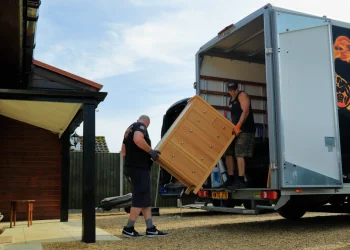When it comes to custom clothing, the simple t-shirt is like a blank canvas. It can be used to show yourself, build your brand, or make something creative. But the magic isn’t in the fabric itself. It’s in the complicated process of t-shirt printing, which turns a plain shirt into a work of art that you can wear. What are the different types of t-shirt printing? This is important for anyone who wants to make unique clothes, whether for a business, an event, or their own use. This detailed guide will show you the most common methods and talk about their pros and cons as well as the best ways to use them. The busy scene of t-shirt printing London is a great setting for this study because it shows how diverse and forward-thinking the industry is.
T-shirt printing has a long and interesting past. It started out as simple hand-stencilling and has grown to include complex digital and automated methods. These days, picking the right printing method is very important because it affects everything from how bright the colours are to how long the design lasts to how the whole thing feels. There are pros and cons to each method, and what works great for one style might not be the best choice for another. The capital is home to a wide range of experts who can help you make decisions about t-shirt printing London.
Screen printing is probably the most famous and well-known method. In this old method, the ink is pushed onto the cloth through a fine mesh screen. The ink will go where a pattern made on the screen tells it to go. Each colour in the design needs its own screen, which makes the process very time-consuming but very efficient. The result is a strong print with bright colours that lasts a long time. Screen printing works best for easy designs with only a few colours, and it’s especially cheap for making a lot of things. Because the ink is on top of the cloth, it gives it a slightly raised, tactile feel that is unique to this method. Screen printing can be more expensive to set up at first, but the cost per unit goes down a lot as the order size goes up, making it the best choice for large orders. For their large-scale needs, many companies and events in t-shirt printing London use screen printing.
Another way that is becoming more popular is direct-to-garment (DTG) printing. DTG printing is a lot like an inkjet printer, but it works on cloth instead of a stencil like screen printing does. With this method, a special printer sprays water-based inks straight onto the t-shirt. This makes it possible to print with more colour and detail than with screen printing. This method works great for designs, photos, and artwork that are hard to understand or that have colours and small details. DTG is great for small orders and one-time prints because of the fact that each colour doesn’t need to be set up separately. The print feels much softer than a screen print because the ink is mixed with the cloth fibres instead of sitting on top. But DTG printing can cost more per unit when you order more of it, and the colours might not be as bright on dark clothes that don’t have a white base. DTG is a big name in the t-shirt printing London scene because it is easy to customise and offer services on demand.
Sublimation printing is a great choice for people who want a smooth picture that is almost impossible to see. This method is a whole different animal. It uses heat to turn the dye from a solid to a gas, which then binds to the fabric’s polyester threads. With this method, the image is built into the material instead of being added on top. The print is very long-lasting and won’t crack or fade. It also doesn’t feel like anything, which makes it great for performance wear and athletic clothing. Sublimation, on the other hand, can only be used on white or light-colored textile fabrics. Cotton won’t take it. The fact that it is specialised means that it is great for certain situations but not for everyone. When sports teams and brands in t-shirt printing London want to make high-quality clothing that will last, sublimation is often their first choice.
Heat transfer printing is an easy-to-use and flexible alternative to more complicated ways. For this method, a design is printed on special transfer paper, and then the design is put on the t-shirt using a heat press. Vinyl and digital heat transfers are the two major kinds. A pattern is cut out of a sheet of coloured vinyl to make a vinyl heat transfer. This way works well for simple text, numbers, and logos. It’s also commonly used to add your name to sports shirts or make big, one-color graphics. It gives a smooth, sharp finish, but it can feel a little like plastic. One difference is that digital heat transfers let you print in full colour. The design can feel a little stiff at times, and the quality can be very good. However, it may not last as long as other ways. Some designs should only be made once, in small quantities, or with a lot of colours that would be too expensive to screen print. Heat transfers are a great way to do these things. Because this method is easy to use and doesn’t require much skill to start, many businesses that offer t-shirt printing London use it.
After all of these, there is stitching, which is a unique method. Even though it’s not really “printing,” this is a very important way to decorate t-shirts and other clothes. Threads are used in embroidery to stitch an image into the fabric. The end result is a finish that looks very professional and has a lot of character. It lasts a very long time and makes clothes feel high-end. Embroidery works best for small, easy designs like company logos or crests. It’s a common choice for high-end fashion and work uniforms. The price depends on how many stitches are used in the design. It may be more expensive than printing, but the high quality and professional look often make it worth it. In addition to printing, many companies that do t-shirt printing London also offer high-quality stitching services.
The difficulty of your design, the type of fabric you are using, the size of your order, and your budget are some of the important things that affect your choice of t-shirt printing method. Many t-shirts with a two-color pattern need to be made for a charity event. Screen printing is probably the best and most cost-effective way to do this. DTG is the best way to make a single t-shirt with a full-color picture as a birthday gift because it is more detailed and faster. It is best to use vinyl heat transfers when you need to add names and numbers to your team’s outfit. If you have a clear idea of what you want your project to be, t-shirt printing London can help you make an answer that fits your needs. If you know what each method can and can’t do, you can make an informed choice that will make sure your custom clothing not only looks great but also lasts for years.











